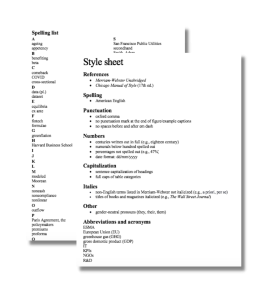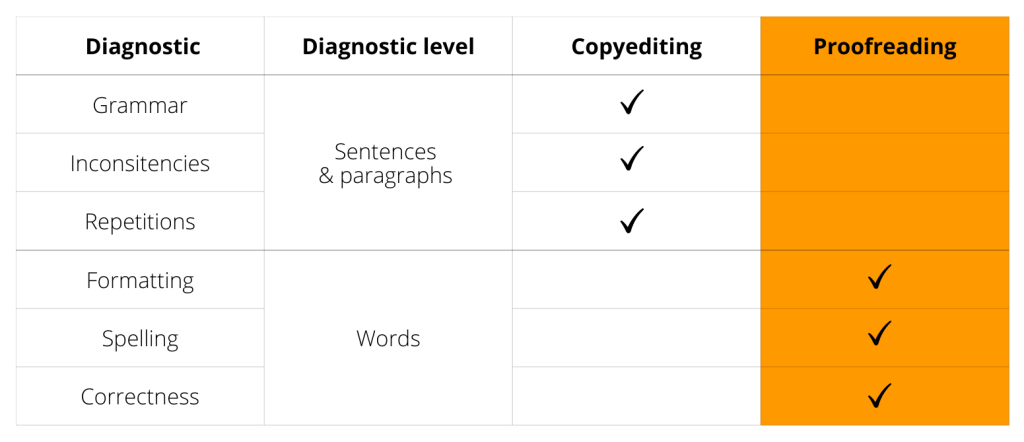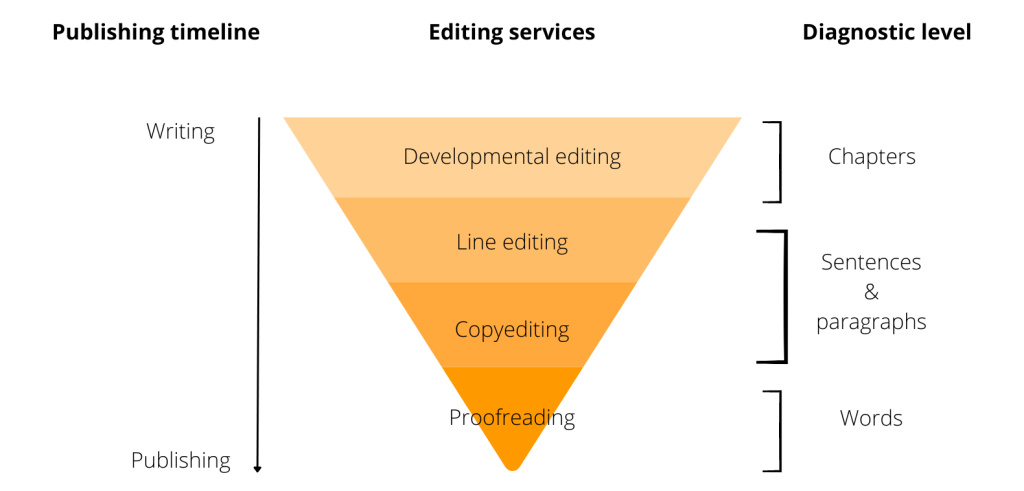Copyediting is an editorial process that checks for clarity, consistency and correctness and deals with spelling, punctuation and grammar issues. This editorial service is great for when you are happy with your argument but want to polish the language to prepare your text for publication.
Copyediting takes place after line editing and before proofreading; it may also be a part of an editorial process called translation editing. After reading this post, you will understand the fundamentals of copyediting, how it differs from other editing services and how and when you should engage a copyeditor.
Why is it important? | What is included? | What is not included? | When to hire an editor? | Finding an editor | Pricing | Copyediting vs proofreading | Copyediting vs line editing | What next? | Other editing
Ensure clarity, conciseness and correctness
Address styling and language inconsistencies
Prevent errors or biased language
Prepare your text for publication
Why is copyediting important?
Copyediting acts as a gatekeeper, spotting any issues relating to consistency, correctness and clarity. Without it, a manuscript sent to a publisher may feature inconsistent character names or low readability. For this reason, copyediting is an essential editing process in preparing a manuscript for publication, especially for self-publishing authors whose texts may not undergo other rounds of editing.
What does copyediting include?
Copyediting focuses on the consistency, clarity and correctness of each sentence in your text. To achieve its objectives, copyediting includes the following tasks:
- correcting grammar, spelling and punctuation
- removing sentence-level redundancies
- ensuring adherence to the language localisation conventions (e.g. UK vs. US English spelling)
- ensuring proper sentence structure and accurate word order
- creating an edited version (with tracked changes and comments) and a clean copy
- conforming to a style guide (e.g. Chicago, APA) or other references (e.g. Oxford Dictionary for Writers and Editors)
- checking names, dates and titles
- ensuring styling and language consistency
- flagging biased or insensitive language or jargon
- checking figures, tables and images against the text.
 A text that has undergone copyediting should return to you as a marked-up manuscript with tracked changes and comments from the editor accompanied by a style sheet. A style sheet lists choices governing your text, such as spelling, punctuation, capitalisation and treatment of abbreviations, but also the point of view or narration, to ensure consistency. The style sheet should also help prepare the text for publication, including during copyediting, when more precise decisions about spelling and styling are finalised. It will then guide the proofreading to ensure the text is completely consistent.
A text that has undergone copyediting should return to you as a marked-up manuscript with tracked changes and comments from the editor accompanied by a style sheet. A style sheet lists choices governing your text, such as spelling, punctuation, capitalisation and treatment of abbreviations, but also the point of view or narration, to ensure consistency. The style sheet should also help prepare the text for publication, including during copyediting, when more precise decisions about spelling and styling are finalised. It will then guide the proofreading to ensure the text is completely consistent.
What is not included in copyediting?
Because copyediting diagnoses issues at a sentence level, more overarching changes or suggestions are outside the scope of this editorial process; they may include:
- removing chapter-level redundancies
- making suggestions for improvement, deletions or additions
- improving overall flow, tone or structure.
Formatting and spellchecking are also not a part of the copyediting service since they are usually performed during proofreading.
When should you hire a copyeditor?
Two processes should take place before copyediting: developmental editing and line editing. Developmental editing covers the ‘big picture’ (such as plot line or argumentation sequences, perspective or structure). Effective line editing reveals the authorial voice by addressing clarity, vocabulary and tone. Only then can copyediting happen, working on sentence-level clarity, consistency and correctness.
What should you consider when hiring a copyeditor?
It is crucial to find a copyeditor who can understand your text’s needs and has prior experience working with the genre of your text. The editor should also be a member of a professional editorial body, ensuring they likely received formal training and follow a code of practice. You can also request a sample edit to ensure that they are the right fit for your text.
Ask if the copyeditor can do a sample edit
Copyeditors may have different processes, but a sample edit is always a good way for the copyeditor to understand the level of editorial intervention required and estimate time and cost. It will also help you (the author) get an idea of how they will edit your text. Above all, carrying out a sample edit before signing a contract ensures that both parties have the same expectations and understand what work will be undertaken under the umbrella of copyediting.
Check what the copyeditor reads and edits the most
Find out what is the copyeditor’s specialism. Knowing what genre they read and edit most often will tell if copyediting your text is within the editor’s skillset. Examples of their past work and clients’ testimonials will demonstrate a track record of working with the genre of your choice. That is a good reassurance that they can deliver a valuable service.
Find out about the copyeditor’s qualifications
Joining a professional body that offers a peer network and training is one of the ways that copyeditors may keep up with their professional development. Global organisations for editors, such as the Editorial Freelancers Association, offer such opportunities. In the UK, there is the Chartered Institute of Editing and Proofreading; in North America — ACES: The Society for Editing and the Northwest Editors Guild.
Language is not a static monolith; it evolves with our culture, society, science and technology, changing and developing over time. For this reason, perhaps, editors, more than other professional groups, must not neglect their professional development to stay up-to-date with the developments in their subject matter. So, when hiring a line editor, it might be worth checking if they are a member of any accredited organisation.
How much should you pay for copyediting?
For instance, current hourly rates for copyediting suggested by the Chartered Institute of Editing and Proofreading start from £35.75. Professional editors can justify quoting hourly rates in this region with their expertise, training and experience. If you receive a lower estimation for copyediting, the service might likewise represent a lower editing quality.
Note that what goes into the editor’s pay exceeds what meets the eye. Copyeditors copyedit the text and compile a style sheet, but also they first read the entire text to understand what level of editorial intervention is needed.
Likewise, a copyeditor must simultaneously record their editing decisions and suggestions for improvement for the author. They usually also keep separate notes that they consult if the client has any questions about their edits. This is because every edit should be intentional and justifiable.
It is unacceptable for a copyeditor to be unable to defend the changes they introduced with the support of references, such as a style guide or dictionary, language localisation or other relevant and recognised convention.
What is the difference between copyediting and proofreading?
Copyediting addresses the flow and cohesiveness of paragraphs and sentences, while proofreading ensures that words in the text function correctly and consistently. Proofreading takes place after copyediting and is responsible for cleaning up mechanical inconsistencies overlooked throughout the previous editing process.
For instance, a copyeditor should check if the figures, tables and illustrations convey the information that the text references and their captions likewise describe their content. In contrast, a proofreader will be concerned if the captions of figures, tables and illustrations have been numbered correctly.

What is the difference between copyediting and line editing?
Copyediting takes place after line editing and works closely with grammar and spelling, addressing language and styling inconsistencies. On the other hand, line editing ensures that your plot line or argument is conveyed in the clearest and most appealing way possible. A copyedit should occur when you are happy with your argument but want to polish the presentation of the language.
One similarity between copyediting and line editing is that both services work with sentences and paragraphs. However, copyediting is more granular, checking for consistency and correctness of language. In contrast, line editing takes place on a larger scale, ensuring that an author’s voice speaks clearly to its target reader.
Another commonality is that both services partake in creating a style sheet, which is the complete record of the language and styling decisions taken by the author and editor to ensure clarity and consistency of the text.

What should happen after copyediting?
After copyediting, the text can next undergo proofreading. Proofreading is a light-touch, final intervention without any significant changes, checking if all the language, formatting and styling decisions made during editing have been consistently reflected in the text. Proofreading ensures that spelling, punctuation and grammar are correct and there are no format and layout issues. It is a final check before publishing your text. Proofreading usually takes place after the text is typeset. (Typesetting is the process of arranging a physical or digital version of the manuscript, including letters, symbols and glyphs, onto a page so it is print-ready.)
Can a copyeditor do other types of editing?
Yes and no. Yes, because many editors can perform different editorial services, and when considering employing the copyeditor to carry out another editorial service, find out their competencies. For the same reason, the answer may be ‘no’ because they might not be trained to carry out the more granular processes like proofreading or those diagnosing the text from a bird’s eye view, such as developmental editing. Another reason could be that the more one works with a text, the more one becomes familiar with it, and perhaps it might be challenging for the same editor to offer a fresh eye for another round of editing.



